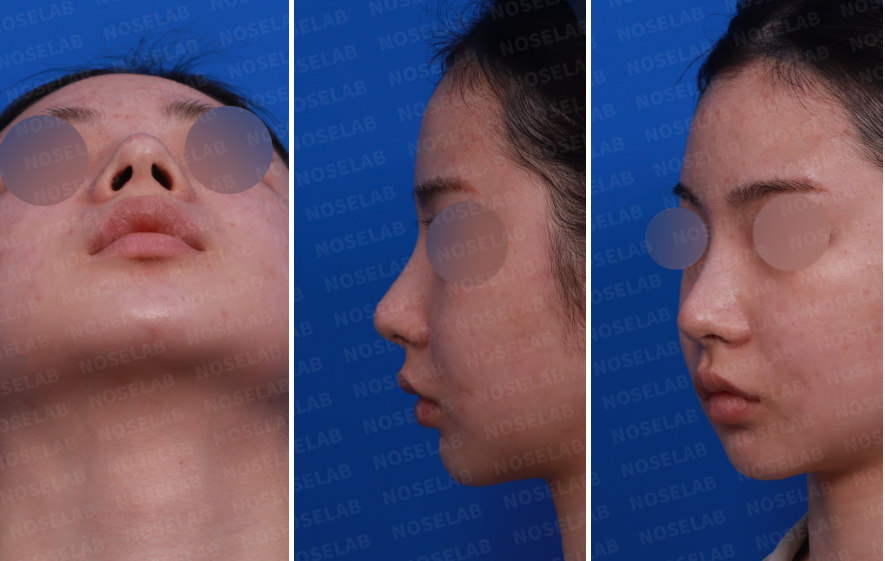Hello, this is Dr. Cha-Young Kang, Director of Nose Lab Clinic.
Today, I’ll share a case of a patient who initially underwent filler and thread lift treatments to improve her nose shape but decided to pursue surgical correction for a more refined, lasting outcome. Through this case, I’ll explore the limitations of non-surgical treatments, the advantages of surgical approaches, and the benefits of closed rhinoplasty.
Patient’s Concerns: Dissatisfaction with Non-Surgical Results
The patient consulted our clinic with these concerns:
General satisfaction with her nose’s overall shape but wanting a more refined result
Desire to reduce the appearance of a bulbous tip
A need to correct the slight deviation in her bridge
Preference for a nose shape that complements her facial proportions
1. Consultation and Customized Surgical Planning
During our initial consultation, I carefully assessed her facial features and identified the following areas of concern:
Pre-Surgery Design Consultation Photos
Although filler and threads initially provided a general shape, her nose appeared somewhat rounded and slightly asymmetrical.
Irregularities in her bridge surface and asymmetry were noticeable.
The nasal tip appeared slightly droopy.
Her chin was relatively small, which contributed to a recessed profile.
Pre-Surgery Design Consultation Photos
To address these concerns, we crafted a customized surgical plan:
Perform a septal extension graft using autologous rib cartilage to add definition and stability to the nasal tip.
Reposition and suture the alar cartilage to reshape the bulbous tip and correct nostril asymmetry.
Completely remove residual filler and threads, then place a silicone implant in the bridge to correct the deviation.
Insert a 6mm silicone chin implant through an intraoral incision to balance her overall profile.
2. Surgical Approach: Closed Rhinoplasty for Precision and Minimal Downtime
I perform all rhinoplasty procedures using a closed approach, which was ideal for this patient as well. Benefits of closed rhinoplasty include:
Minimal postoperative swelling and faster recovery
No visible columella scars
Enhanced precision for delicate adjustments
Immediate assessment of the final results post-surgery
One key aspect of this surgery was the meticulous removal of filler and threads, requiring careful technique to avoid affecting surrounding tissue. Using a minimal incision, I removed all foreign material with precision.
To enhance the nasal tip’s shape and stability, I performed a septal extension graft with autologous rib cartilage, while a silicone implant was centered along the bridge to correct the deviation. To address nostril asymmetry, I repositioned and sutured the alar cartilage. Finally, a silicone implant was added to the chin to improve balance and proportion.
3. Post-Surgical Results
Comparing the patient’s pre- and post-surgery photos immediately revealed several key improvements:
Before Surgery (Left) / Immediately After Surgery (Right)
Before Surgery (Left) / Immediately After Surgery (Right)
A smooth, naturally straight nasal line that harmonized with her features
A refined, more sophisticated nasal tip
A centered and smooth bridge, correcting previous asymmetry
Balanced nostrils with improved symmetry
Enhanced facial balance with the addition of the chin implant
Before Surgery (Left) / Immediately After Surgery (Right)
Before Surgery (Left) / Immediately After Surgery (Right)
Most notably, the uneven, rounded areas caused by the previous filler and thread treatments were completely corrected, achieving a harmonious and natural nasal contour.
4. Final Thoughts: The Benefits of Surgical Correction Over Non-Surgical Methods
This case demonstrates the limitations of non-surgical treatments, such as filler and thread lifts, which can provide short-term enhancements but often lack the stability required for lasting results. Non-surgical methods may provide a temporary lift, but achieving precise corrections—particularly for tip reshaping or straightening—often requires surgical intervention. Closed rhinoplasty allowed us to provide a refined, natural look with minimal scarring and a quicker recovery.
For Those Considering Rhinoplasty: Key Advice
If you’ve tried filler or thread lifts without satisfaction, or if you’re considering rhinoplasty for the first time, this case may offer some clarity. Non-surgical treatments like fillers and threads can temporarily add height but are unlikely to provide long-term shape stability and may eventually require correction. Surgical rhinoplasty remains the best option for precise reshaping, especially for the nasal tip or to address a deviation. It’s also essential to remember that non-surgical methods carry certain risks, such as skin necrosis or vision loss, underscoring the importance of choosing a safe, effective approach.
If you’re considering rhinoplasty, I encourage you to consult with a specialist to determine the best approach for your individual needs. At Nose Lab Clinic, we prioritize safety and satisfaction, working to deliver optimal results that enhance each patient’s natural beauty.
Thank you,
Dr. Cha-Young Kang, Director of Nose Lab Clinic.








Comments